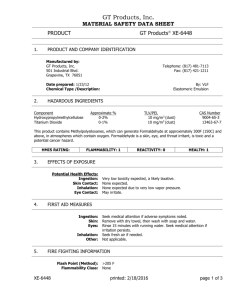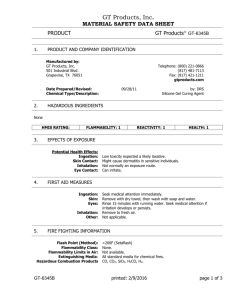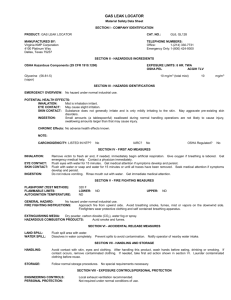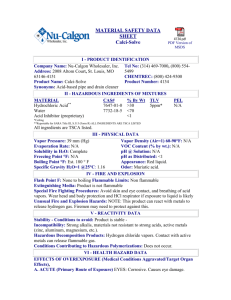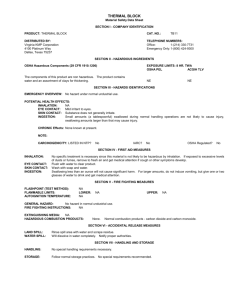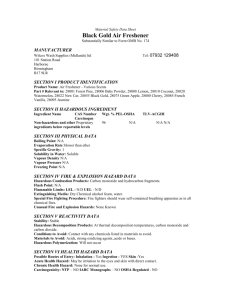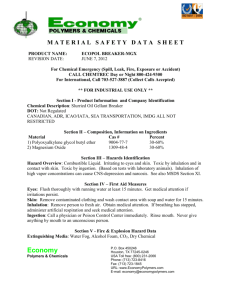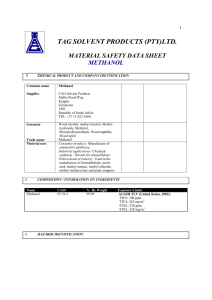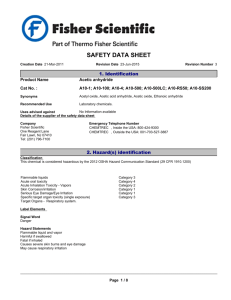MATERIAL SAFETY DATA SHEET - Economy Polymers & Chemicals
advertisement
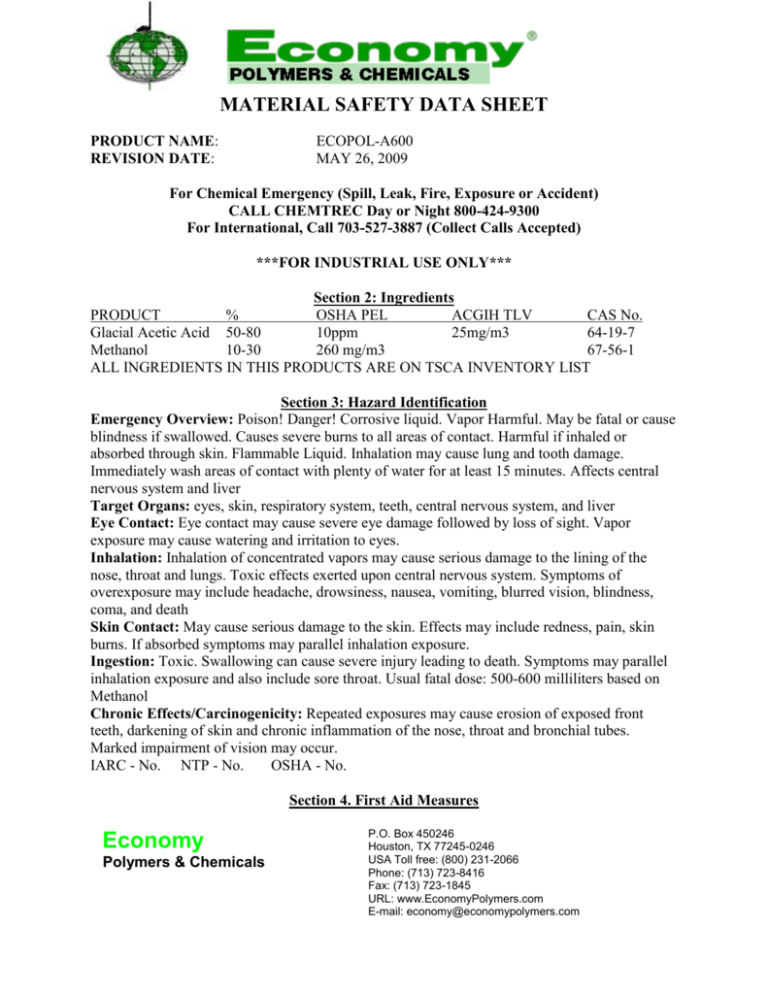
MATERIAL SAFETY DATA SHEET PRODUCT NAME: REVISION DATE: ECOPOL-A600 MAY 26, 2009 For Chemical Emergency (Spill, Leak, Fire, Exposure or Accident) CALL CHEMTREC Day or Night 800-424-9300 For International, Call 703-527-3887 (Collect Calls Accepted) ***FOR INDUSTRIAL USE ONLY*** Section 2: Ingredients PRODUCT % OSHA PEL ACGIH TLV CAS No. Glacial Acetic Acid 50-80 10ppm 25mg/m3 64-19-7 Methanol 10-30 260 mg/m3 67-56-1 ALL INGREDIENTS IN THIS PRODUCTS ARE ON TSCA INVENTORY LIST Section 3: Hazard Identification Emergency Overview: Poison! Danger! Corrosive liquid. Vapor Harmful. May be fatal or cause blindness if swallowed. Causes severe burns to all areas of contact. Harmful if inhaled or absorbed through skin. Flammable Liquid. Inhalation may cause lung and tooth damage. Immediately wash areas of contact with plenty of water for at least 15 minutes. Affects central nervous system and liver Target Organs: eyes, skin, respiratory system, teeth, central nervous system, and liver Eye Contact: Eye contact may cause severe eye damage followed by loss of sight. Vapor exposure may cause watering and irritation to eyes. Inhalation: Inhalation of concentrated vapors may cause serious damage to the lining of the nose, throat and lungs. Toxic effects exerted upon central nervous system. Symptoms of overexposure may include headache, drowsiness, nausea, vomiting, blurred vision, blindness, coma, and death Skin Contact: May cause serious damage to the skin. Effects may include redness, pain, skin burns. If absorbed symptoms may parallel inhalation exposure. Ingestion: Toxic. Swallowing can cause severe injury leading to death. Symptoms may parallel inhalation exposure and also include sore throat. Usual fatal dose: 500-600 milliliters based on Methanol Chronic Effects/Carcinogenicity: Repeated exposures may cause erosion of exposed front teeth, darkening of skin and chronic inflammation of the nose, throat and bronchial tubes. Marked impairment of vision may occur. IARC - No. NTP - No. OSHA - No. Section 4. First Aid Measures Economy Polymers & Chemicals P.O. Box 450246 Houston, TX 77245-0246 USA Toll free: (800) 231-2066 Phone: (713) 723-8416 Fax: (713) 723-1845 URL: www.EconomyPolymers.com E-mail: economy@economypolymers.com Eye Contact: Irrigate immediately with large quantity of water for at least 15 minutes. Get medical attention immediately. Inhalation: Remove to fresh air. Give artificial respiration if necessary. If breathing is difficult, give oxygen. Skin Contact: Flush with plenty of water for at least 15 minutes. Call a physician if irritation develops. Ingestion: Do not induce vomiting. Give large quantity of water. Call a physician immediately. Section 5. Fire Fighting Measures Flash Point: 52°F (Methanol) Method Used: CC Extinguishing Media: Use water spray, dry chemical, alcohol foam, or carbon dioxide for extinguishing the surrounding fire Water spray can be used to dilute spills to non-flammable mixtures. Fire & Explosion Hazards: Above flash point, vapor-air mixtures are explosive within flammable limits noted above. Contact with strong oxidizers may cause fire. Vapors can flow along surfaces to distant ignition source and flash back. Reacts with most metals to produce hydrogen gas, which can form explosive mixture with air Fire Fighting Instructions: Use normal procedures/instructions. Fire Fighting Equipment: Use protective clothing and breathing equipment appropriate for the surrounding fire. Section 6. Accidental Release Measures Ventilate area of leak or spill. Wear appropriate personal protective equipment as specified in Section VIII. Contain and recover liquid when possible. Collect liquid in an appropriate container or absorb with an inert material (e. g., vermiculite, dry sand, earth), and place in a chemical waste container. Do not use combustible materials, such as saw dust. Do not flush to sewer! US Regulations (CERCLA) require reporting spills and releases to soil, water and air in excess of reportable quantities. The toll free number for the US Coast Guard National Response Center is (800) 424-8802. Section 7. Handling and Storage Keep in a tightly closed container. Store in a cool, dry, ventilated area. Protect against physical damage. Separate from acids and alkalis. Containers of this material may be hazardous when empty since they retain product residues (vapors, liquid); observe all warnings and precautions listed for the product. As with all chemicals, wash hands thoroughly after handling. Avoid contact with eyes and skin. Protect from freezing and physical damage. SAFETY STORAGE CODE: Corrosive, Flammable Section 8. Exposure Control/Personal Protection Engineering Controls: A system of local and/or general exhaust is recommended to keep employee exposures below the Airborne Exposure Limit. Economy Polymers & Chemicals P.O. Box 450246 Houston, TX 77245-0246 USA Toll free: (800) 231-2066 Phone: (713) 723-8416 Fax: (713) 723-1845 URL: www.EconomyPolymers.com E-mail: economy@economypolymers.com Skin Protection: Wear impervious protective clothing, including boots, gloves, lab coat, apron or coveralls, as appropriate, to prevent skin contact. Eye Protection: Use chemical safety goggles and/or a full face shield where splashing is possible. Maintain eye wash fountain and quick-drench facilities in work area. Section 9. Physical and Chemical Properties Appearance: Clear, colorless liquid Vapor Pressure: Not Determined pH: 2 – 4 Odor: strong vinegar Boiling Point (°C): 64.5oC Solubility in Water: Infinite Melting Point (°C): Not Determined Specific Gravity: 1.035 Section 10. Stability and Reactivity Chemical Stability: Stable under normal conditions of use and storage. Keep away from heat sparks, and flame. Incompatibility: Strong bases, strong oxidizers, chromic acid, sodium peroxide, nitric acid, perchloric acid Hazardous Decomposition Products: When heated to decomposition it emits irritating fumes. Hazardous Polymerization: Will not occur. Section 11. Toxicological Data Glacial Acetic Acid: LD50, Oral, Rat 3310 mg/kg, details of toxic effects not reported other than lethal dose value; LD50, Dermal, Rabbit (Acetic Acid): 1.06 g/kg; LC50, Inhalation, Mouse (Acetic Acid): 5620 ppm/1 hr.; LD50, Oral, Rat (Sodium Acetate): 3530 mg/kg; Information obtained from RTECS ("Registry of Toxic Effects of Chemical Substances"). Methyl Alcohol (Methanol): Oral rat LD50: 5628 mg/kg; inhalation rat LC50: 64000 ppm/4H; skin rabbit LD50: 15800 mg/kg; Irritation data-standard Draize test: skin, rabbit: 20mg/24 hr. Moderate; eye, rabbit: 100 mg/24 hr. Moderate. Investigated as a mutagen, reproductive effector. Section 12. Ecological Information Ecotoxicological Information: Acetic Acid: has high biochemical oxygen demand, and a potential to cause oxygen depletion in aqueous systems, low potential to affect aquatic organisms and a low potential to affect the growth of some plant seedlings. Methanol: When released into the soil, this material is expected to readily biodegrade. When released into the soil, this material is expected to leach into groundwater. When released into the soil, this material is expected to quickly evaporate. When released into the water, this material is expected to have a half-life between 1 and 10 days. When released into water, this material is expected to readily biodegrade. When released into the air, this material is expected to exist in the aerosol phase with a short half-life. When released into the air, this material is expected to be readily degraded by reaction with photochemically produced hydroxyl radicals. When released Economy Polymers & Chemicals P.O. Box 450246 Houston, TX 77245-0246 USA Toll free: (800) 231-2066 Phone: (713) 723-8416 Fax: (713) 723-1845 URL: www.EconomyPolymers.com E-mail: economy@economypolymers.com into air, this material is expected to have a half-life between 10 and 30 days. When released into the air, this material is expected to be readily removed from the atmosphere by wet deposition. Chemical Fate Information: This material is expected to be slightly toxic to aquatic life. Section 13. Disposal Considerations Disposal Method: Disposal should be made in accordance with federal, state, and local regulations Contaminated Packaging: Follow all applicable national or local regulations. Section 14. Transport Information U.N. / N.A. Number: UN2924 D.O.T. Shipping Name: Flammable Liquids, corrosive, n.o.s. (contains glacial acetic acid, methanol) D.O.T. Hazard Class: 3 (8) Packing Group: II D.O.T. Label: Flammable, Corrosive Section 15. Regulatory Information OSHA Status: These items meet the OSHA Hazard Communication Standard (29 CFR 1910.1200) definition of a hazardous material. TSCA Status: All components of this solution are listed on the TSCA Inventory or are mixtures (hydrates) of items listed on the TSCA Inventory. CERCLA Reportable Quantity: Acetic Acid- 6250 pounds. Sara Title III: Section 302 Extremely Hazardous Substances: Not Applicable Section 311/312 Hazardous Categories: Acute Health Hazard, Chronic Health Hazard, Fire Hazard, Reactivity Hazard Section 313 Toxic Chemicals: No. Section 16. Other Information NFPA Ratings: Health: 2 Flammability: 3 Reactivity: 0 HMIS Ratings: Health: 2 Flammability: 3 Reactivity: 0 THE INFORMATION WHICH IS IN THIS DOCUMENT IS BASED UPON AVAILABLE DATA AND BELIEVED TO BE CORRECT; HOWEVER, THE PRODUCT DISCUSSED HEREIN IS SOLD WITHOUT ANY WARRANTY, EXPRESSED OR IMPLIED, AS TO MERCHANTIBILITY OR FITNESS FOR A PARTICULAR PURPOSE. Economy Polymers & Chemicals P.O. Box 450246 Houston, TX 77245-0246 USA Toll free: (800) 231-2066 Phone: (713) 723-8416 Fax: (713) 723-1845 URL: www.EconomyPolymers.com E-mail: economy@economypolymers.com
